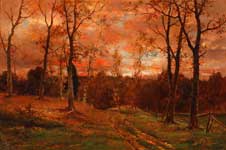Born and raised in Pittsburgh, Linford was a member of the "Gillespie Group," a collection of artists who met daily at the downtown Gillespie Gallery to discuss art theory and other esoteric issues concerning artistic creation. Among the group's members were artists David Gilmore Blythe and George Hetzel, the latter who became Linford's teacher and friend. It is believed that Hetzel and Linford together discovered the natural, untainted beauty of Scalp Level while on a fishing excursion to the region in 1866.
Despite having never travelled abroad, Linford's highly-recognizable landscapes were clearly influenced by the French Barbizon School with their loose brushwork and naturalist play of light and shadow in darker tones of color. His favorite subjects tended to be forest interiors and tree-filled landscapes, and he was especially drawn to the birch trees found at Scalp Level. Exceptional at observing nature in intimate settings, Linford captured that beauty on canvas using shadows, reflected light and texture.
In 1877, Linford relocated to Philadelphia where he remained until 1893. There, he exhibited at the Pennsylvania Academy of Fine Arts. It is documented that he also spent time living in New York in 1890 where he exhibited at the National Academy of Design. His final years were spent in Plainfield, New Jersey, where he died at the young age of 51.
|
|



The Afterglow, 1887
Oil on canvas, 24" x 36"
Collection of the Westmoreland Museum of American Art, Greensburg, PA
Gift of the Constance Mellon Bequest, 1985.17
Click here for more information about this painting.